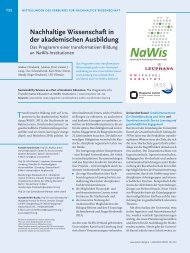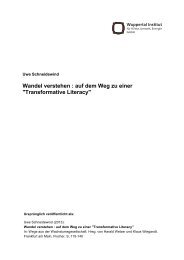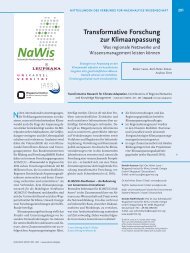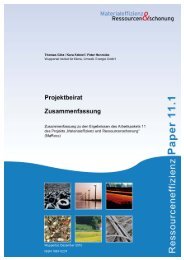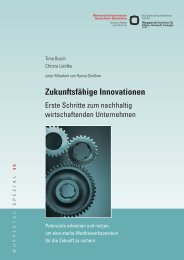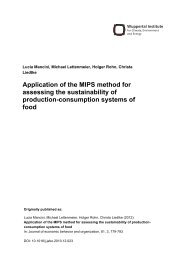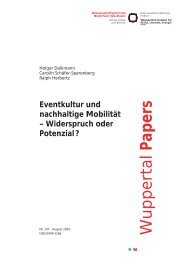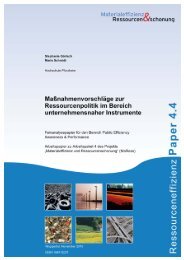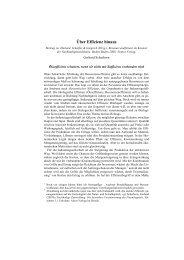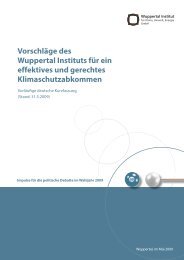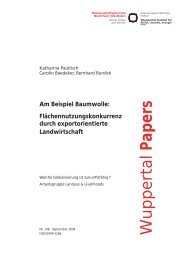Resource Efficiency Atlas - Publication Server of the Wuppertal ...
Resource Efficiency Atlas - Publication Server of the Wuppertal ...
Resource Efficiency Atlas - Publication Server of the Wuppertal ...
Create successful ePaper yourself
Turn your PDF publications into a flip-book with our unique Google optimized e-Paper software.
Effects Region and Country<br />
Material<br />
Water m 2<br />
Energy<br />
Surface<br />
fields<br />
Europe<br />
Switzerland<br />
Holcim AG in cooperation with <strong>the</strong> Institute for Building<br />
and Environment (IBU) and <strong>the</strong> University for Technology<br />
Rapperswill.<br />
Barriers and Risks<br />
Old gravel pits are frequently used for disposal <strong>of</strong> exca-<br />
vated material from construction sites. An increased use<br />
<strong>of</strong> secondary construction materials and <strong>the</strong> associated<br />
decrease <strong>of</strong> gravel exploitation could lead to longer transportation<br />
distances <strong>of</strong> excavated material to <strong>the</strong> nearest<br />
gravel pit. This would worsen <strong>the</strong> environmental balance<br />
significantly. Long distances should also be avoided when<br />
transporting construction waste materials to appropriate<br />
processing sites. According to <strong>the</strong> lifecycle assessment<br />
done by <strong>the</strong> Holcim AG, secondary construction materials<br />
should, thus, only be used if <strong>the</strong> transportation distance<br />
amounts to more than 30 km over that <strong>of</strong> primary gravel.<br />
Potentials<br />
Already 80 percent <strong>of</strong> construction waste is currently recycled<br />
in Switzerland. However, <strong>the</strong>se materials are usually<br />
used for inferior building materials in <strong>the</strong> civil engineering<br />
underground; <strong>the</strong> remaining 20 percent are disposed<br />
Construction waste as raw material<br />
(Picture: Juliette Chrétien, Zürich)<br />
<strong>of</strong> as waste. At present, due to energetic redevelopment<br />
measures, <strong>the</strong> need <strong>of</strong> building materials shifts more and<br />
more from civil engineering to building construction: A resource<br />
model <strong>of</strong> <strong>the</strong> city <strong>of</strong> Zurich showed that <strong>the</strong> input<br />
<strong>of</strong> building materials for urban building construction adds<br />
up to 780,000 tons, whereas <strong>the</strong> input for civil engineering<br />
amounts for 104,000 tons. Thus, an increased demand<br />
for high-quality recycling materials for application in <strong>the</strong><br />
building construction can be expected in <strong>the</strong> future.<br />
Fur<strong>the</strong>r information<br />
www.kiesfuergenerationen.ch<br />
TEC21 (2010): Recycling-Beton.<br />
AWEL Kanton Zürich<br />
Abteilung Abfallwirtschaft und Betriebe<br />
Weinbergstrasse 34<br />
8090 Zürich, Switzerland<br />
www.awel.zh.ch<br />
Ressourceneffizienzatlas<br />
<strong>Resource</strong> <strong>Efficiency</strong> <strong>Atlas</strong> 67



